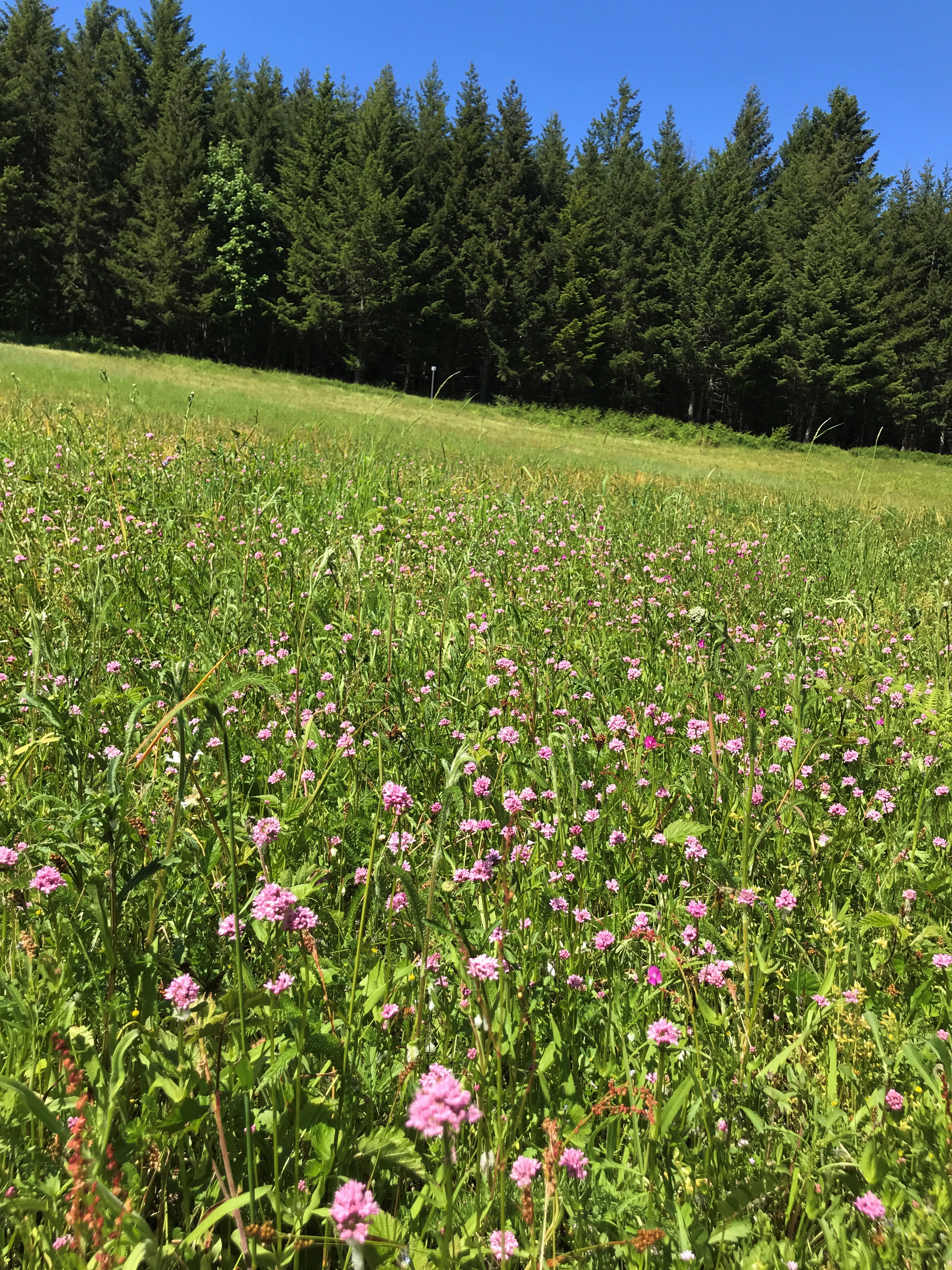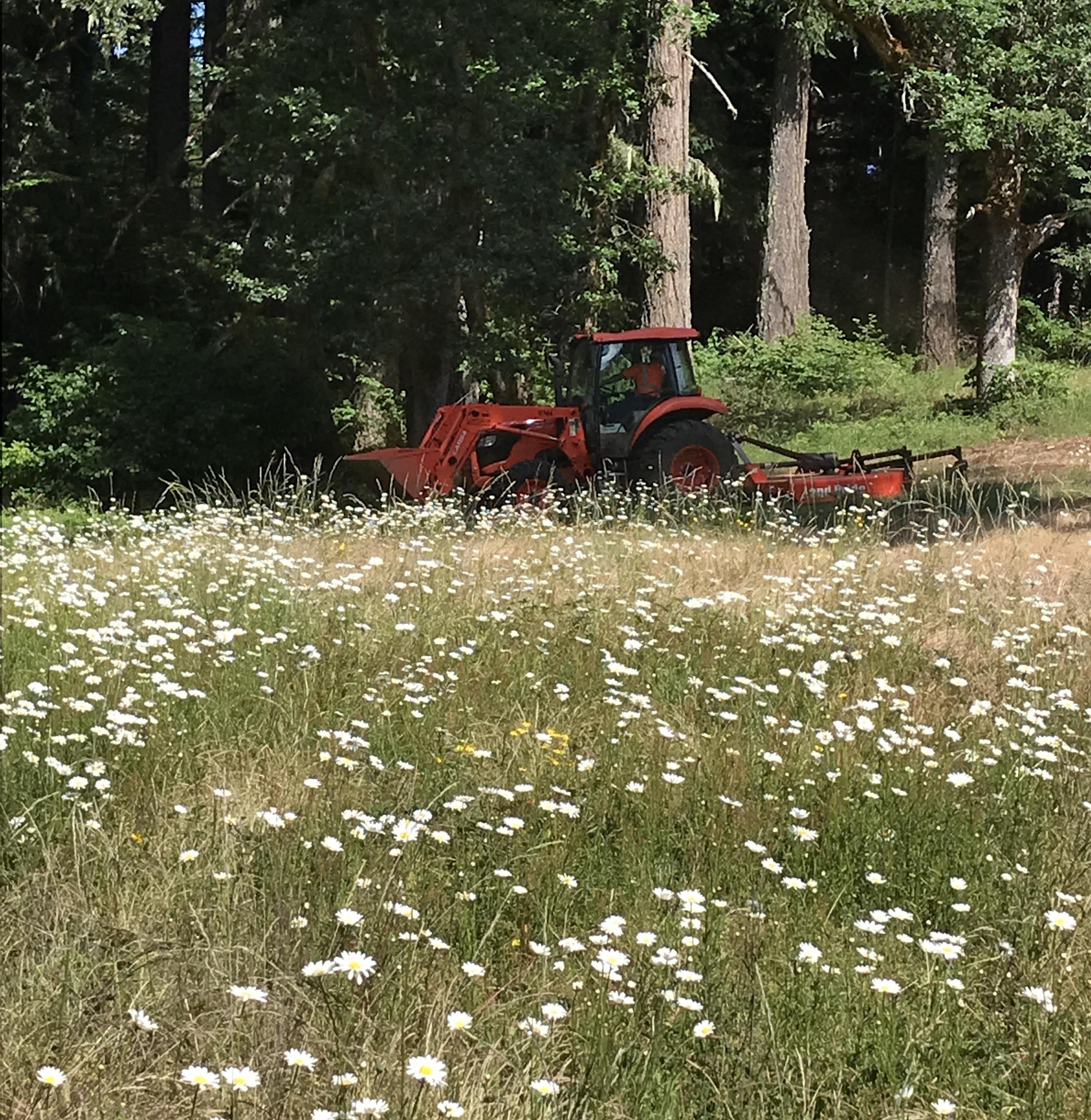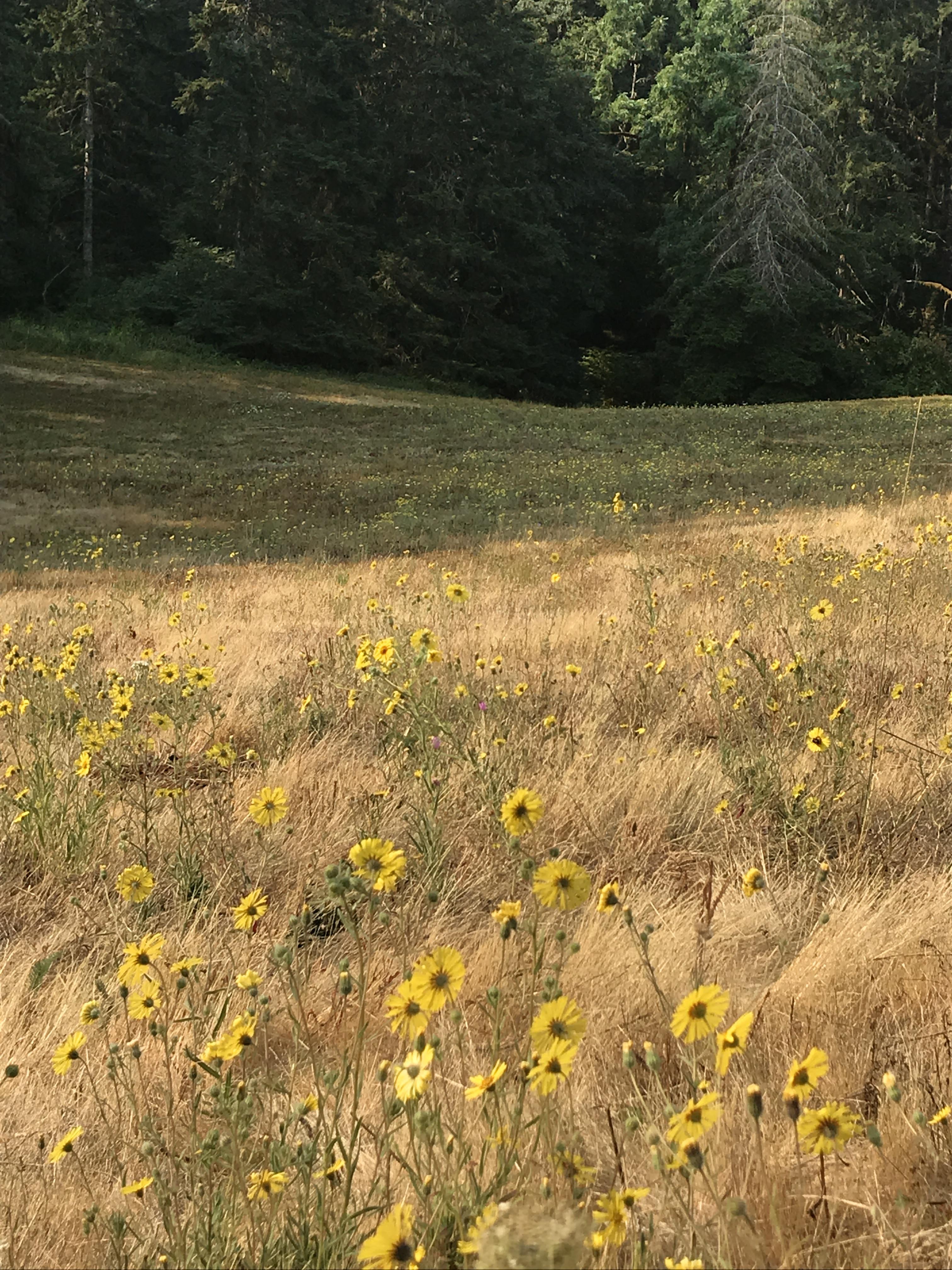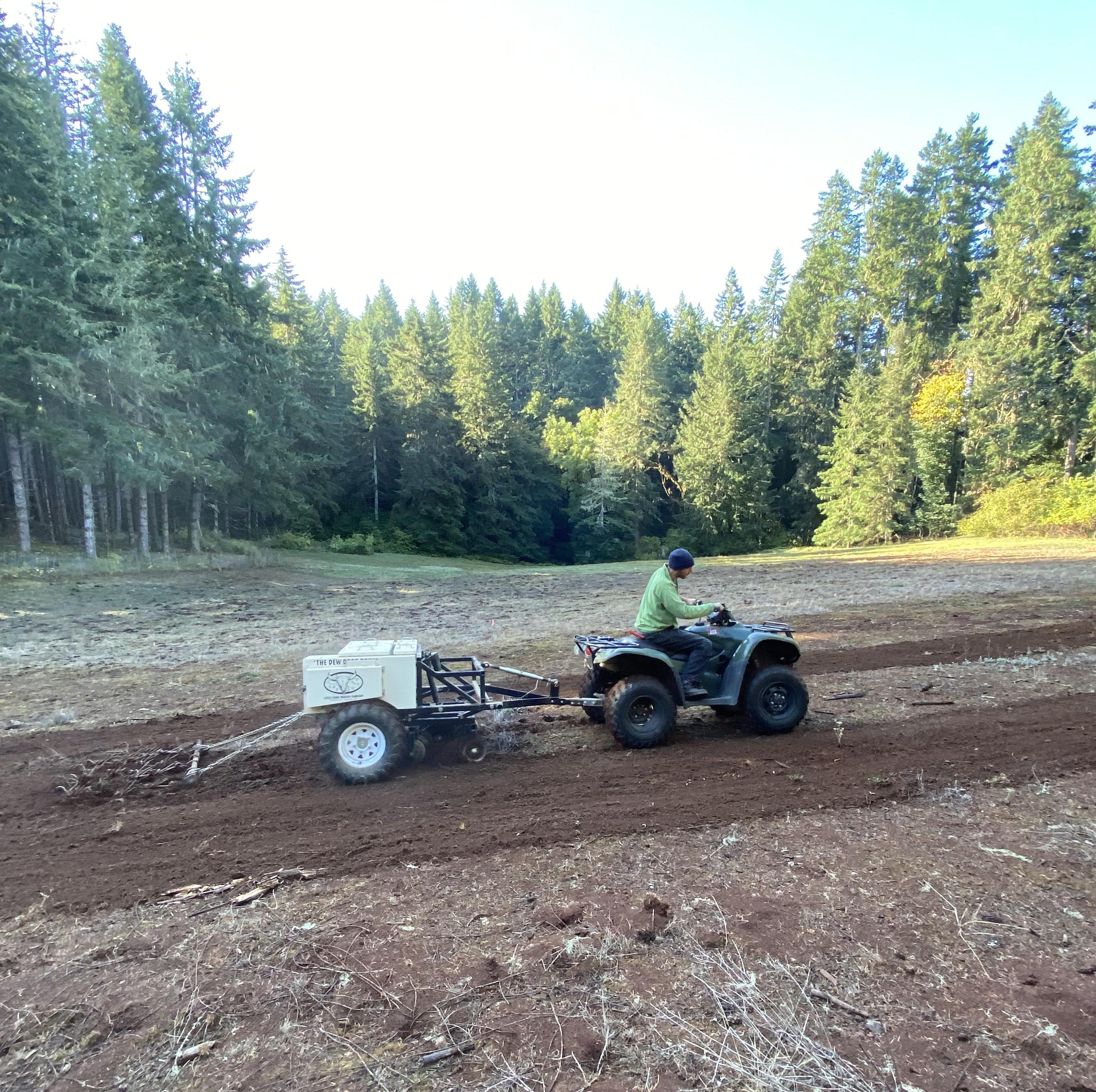
A meadow you’ll see on the Corvallis-To-The-Sea Trail
November 2021
When I began working as a Restoration Ecologist at IAE in 2017, the first project I was assigned to was Old Peak Meadow near Corvallis, Oregon. Many folks in the Corvallis area probably have not been there, or even heard of the meadow, even though it is in the Corvallis Watershed. My guess is that will change soon as the newly-opened C2C Trail (Corvallis-to-the-Sea Trail) passes right by Old Peak Meadow. I thought it would be nice to describe some of the restoration work underway and what you will see at the meadow this spring. So, without further ado, welcome to Old Peak Meadow.
Old Peak Meadow is a rare, mid-elevation, remnant meadow located in the Corvallis Watershed and owned by the City of Corvallis. Historically, it was part of a 160-acre homestead which included open grassland. By the time the original owners sold the property, decades of conifer encroachment had reduced the meadow to approximately one acre.
When the City of Corvallis began managing Old Peak Meadow in 2009, staff and local biologists observed a lack of birds utilizing the area. At this time the vegetation was primarily tall oatgrass (Arrhenatherum elatius), which is an invasive species. The City removed over 100 Douglas fir trees (Pseudotsuga menziesii) to triple the size of the meadow to three acres and they planted 120 shrubs on the eastern edge to create a more diverse habitat for birds. Unfortunately, the shrubs were too tasty for deer to resist, and they ate enough of the biomass to kill all of the new shrubs.
Removing two acres of trees meant that, for the first time in decades, ample sunlight hit the newly expanded meadow. The result was an explosion of the noxious weed, oxeye daisy (Leucanthemum vulgare). A single oxeye daisy is not a problem and is quite pretty, but thousands of them in a small area can negatively impact plant community diversity, pollinator resources and foraging opportunities for wildlife.
In 2014, the City, along with three other partners including IAE, received a grant from the Coast Range Stewardship Fund to improve wildlife habitat at Old Peak by diversifying the plant species composition and vegetation structure of the meadow. In the same year, IAE began treating tall oatgrass with grass-specific herbicide and the Oregon Department of Forestry conducted a prescribed burn to reduce thatch prior to a native seed mix to be sown. Although moist conditions at the time of the burn prevented much of the meadow from burning, it created enough bare ground to allow native seeds to germinate. Today there is a robust population of native species in the southern section of the meadow including wild strawberry (Fragaria virginiana), common yarrow (Achillea millefolia), shortspur seablush (Plectritis congesta), common madia (Madia elegans) and Roemer’s fescue (Festuca roemeri).
In 2015, IAE staff planted 500 shrubs and 20 Oregon white oaks (Quercus garryana) along the eastern edge of the meadow. Deer exclosures were constructed around the shrubs, and volunteers from the Oregon Hunters Association watered the shrubs in the summer in 2016 and 2017 and maintained the exclosures in 2020. To date, over 90% of the shrubs have survived and are providing shade, food and shelter to wildlife.
Treating the oxeye daisy has been the ‘Achilles heel’ of this project. Oxeye daisy is everywhere in the meadow and intermixed with native prairie species. Oxeye daisy is an aggressive invasive species, and once established, can spread rapidly. Each flower can produce up to 200 seeds that remain viable in the soil for several years. The species is also rhizomatous, meaning it has lateral stems that grow underground – manual removal is nearly impossible since new plants can grow from any fragments of rhizomes left in the soil. Using broad-spectrum herbicides is challenging because of the close proximity of oxeye daisy to native species. Although mowing will not kill this perennial species, when it is well-timed, mowing can reduce the spread of the daisy by limiting its seed dispersal.
Consequently, in early July 2017, we mowed the meadow when oxeye daisy was in full bloom, but before seeds began to mature. As a next step, in 2019-2021 we treated a one-acre area with broad-spectrum herbicide to exhaust as much of the oxeye daisy seed bank as possible and remove other non-native species. I am happy to report that this process is working well. There were very few oxeye daisy in the fallowed area this fall, and we were able to sow a native seed mix that contained 23 native species. We used a Dew Drop Drill and a harrow to rough-up the soil to create good seed contact – this should result in good seeding establishment. Another acre of the meadow was put into fallow in 2021, ready for sowing native seed in 2023, and the third acre, which has a good native prairie composition, is being managed by spot spraying.
These positive steps have been the result of a group effort. The City of Corvallis have been fantastic partners and I would especially like to thank Jennifer Ward for supporting this project from the onset and Jeff Hollenbeck for his enthusiasm for keeping the restoration moving forward. The Oregon Hunters Association have had numerous volunteer events over the years and have played an integral role in keeping the shrub ecotone alive and well. Lastly, the U.S. Fish and Wildlife Service was gracious enough to let us use their Dew Drop Drill.
I encourage everyone to go for a hike this spring and visit Old Peak Meadow. It is a beautiful hike through managed forest to the meadow. The northern section of the meadow, adjacent to the trail, should be full of annual wildflowers (the perennials will probably take another year before they flower). The middle section further downslope will be in fallow and the southern section will have a mix of wildflowers. What you will see is restoration in action, partnerships in progress, and a hidden gem in the Oregon Coast Range.
Please note, a permit is required to hike on the Old Peak Road section of the C2C Trail. The annual permit is free and may be obtained from Starker Forests (541-929-2477).
Restoration
Research
Education
Get Involved
Contact
Main Office:
4950 SW Hout Street
Corvallis, OR 97333-9598
541-753-3099
[email protected]
Southwest Office:
1202 Parkway Dr. Suite B
Santa Fe, NM 87507
(505) 490-4910
[email protected]
© 2024 Institute for Applied Ecology | Privacy Policy



